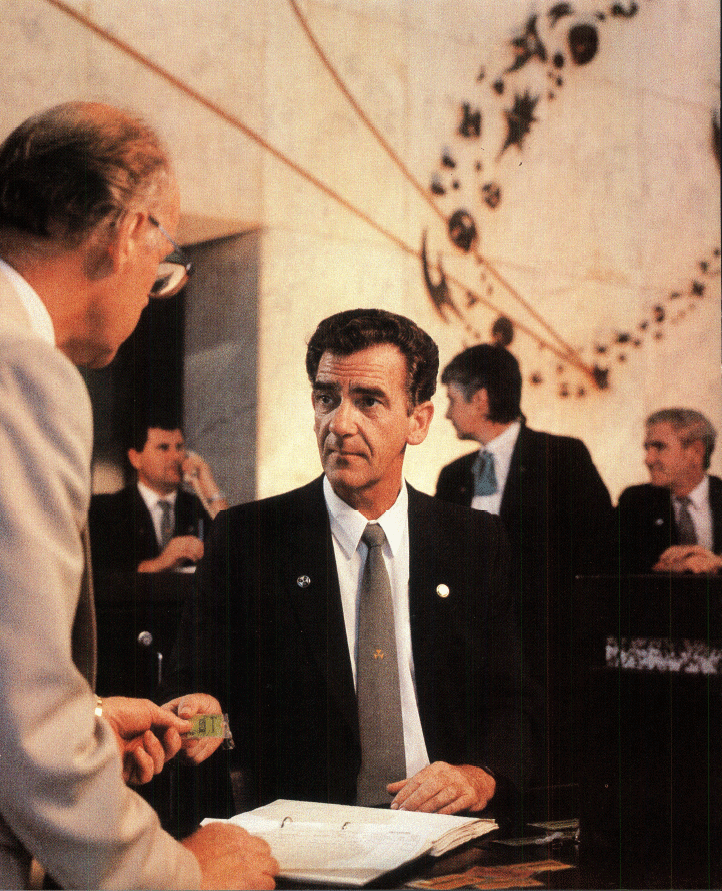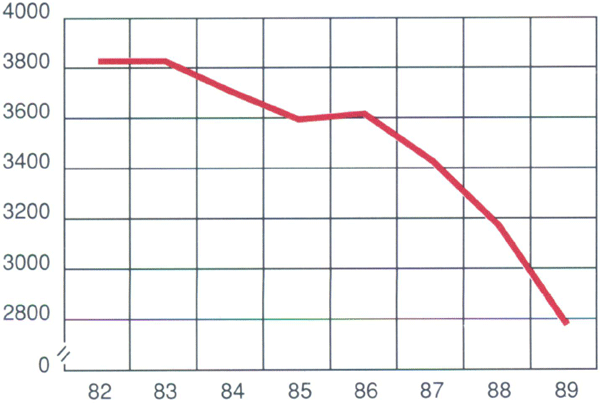Reserve Bank of Australia Annual Report – 1989 The Bank's Staff

The Board thanks all staff for the positive spirit and capable manner in which they have carried out the Bank's responsibilities in the past year.
The trend towards a smaller but more effectively deployed staff continued in 1988/89. A substantial further reduction in overall numbers, following an earlier decline in some activities and rising efficiency, was achieved largely through the voluntary acceptance of redundancy offers made to specific groups of staff. Changes in skills were also called for to match the growing complexity of the financial sector and to handle more sophisticated systems introduced in many areas of the Bank. It has not been easy to retain skilled and experienced people or to recruit suitable new staff. The inability to match remuneration offered in the private sector, long a problem, has become acute, and key staff at various levels continue to be lost. The Board welcomes Government decisions that would allow some of these disparities to be addressed, and hopes those decisions might become effective with minimal further delay.
The staff numbered 2,788 at the end of June 1989. In all, the total fall in numbers over the year was about 400, or 12 per cent. Some 230 officers left under voluntary redundancy arrangements during the year.
The speed of change in the financial system and the greater complexity of central bank operations have emphasised more than ever the importance of staff training. The Bank's internal training facilities were greatly enhanced by the opening during the year of its new training centre at Kirribilli. Dr H.C. Coombs, Governor of the Bank from 1949 to 1968 and a major innovator in financial education, kindly consented to the Centre being named in his honour as the H.C. Coombs Centre for Financial Studies. Since the 17th SEANZA Central Banking Course, the Centre has been in continuous use by the Bank and by other organisations for training purposes.
About 200 officers were receiving assistance from the Bank for study in Australia at the end of 1988/89, with a further 4 officers undertaking post-graduate study overseas. Experience in world financial markets continues to be provided by work opportunities in the Bank's London and New York offices. The Bank has also maintained an active programme of short-term secondments to other financial institutions, and remains grateful for the assistance and co-operation received.
22 TOTAL RESERVE BANK STAFF
as at 30 June

| Bank staff | 30 June 1989 |
|---|---|
| Monetary policy | 218 |
| Financial system surveillance | 125 |
| Note printing | 488 |
| Currency distribution | 253 |
| Banking and registry services | 745 |
| Accounting and computer services | 171 |
| Building security and maintenance | 419 |
| Other support functions | 369 |
| 2,788 |
The Bank again employed a number of young people under the Australian Government Trainees' Scheme and under the auspices of AIESEC, an international student body.
A formal set of procedures for handling grievances was introduced in September 1988, with the establishment of a Grievance Authority. The Authority consists of a Chairperson, appointed from outside the Bank, and two staff members selected from a Bank-nominated and union-nominated panel. The role of the Authority is independently to review and settle grievances referred to it.
The Bank continued in 1988/89 its programme for equal opportunity in employment. A first annual report, in terms of the Equal Employment Opportunity (Commonwealth Authorities) Act 1987, was tabled in the Commonwealth Parliament during the year.
Changes in Senior Management
Mr J.S. Mallyon, Chief Administrative Officer, resigned in March 1989 after a distinguished career. He was also a member of the Campbell Committee of Inquiry into the Australian Financial System and the inaugural Chairman of the Australian Payments System Council.
Mr D.R. Parr, Adviser, retired in July 1989. He had filled a number of senior positions during his career, including that of the Bank's Chief Representative in Europe and General Manager of Note Printing Branch.
Dr Jeffrey Carmichael resigned in June 1989 from his position as Chief Manager, Financial Markets Group, to take up an academic post. Dr Carmichael was until recently the Bank's Representative in New York.
Mr L.J. Phelps resigned in November 1988 to join the private finance sector. Mr Phelps had been Deputy Chief Manager of Domestic Markets Department.
Mr W.P. Sharp retired in March 1989. He was the Bank's Representative in New York from 1984 to 1987.